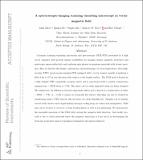A spectroscopic-imaging scanning tunneling microscope in vector magnetic field
Abstract
Cryogenic scanning tunneling microscopy and spectroscopy (STM/STS) performed in a high vector magnetic field provide unique possibilities for imaging surface magnetic structures and anisotropic superconductivity and exploring spin physics in quantum materials with atomic precision. Here, we describe the design, construction, and performance of a low-temperature, ultra-high-vacuum (UHV) spectroscopic-imaging STM equipped with a vector magnet capable of applying a field of up to 3 T in any direction with respect to the sample surface. The STM head is housed in a fully bakeable UHV compatible cryogenic insert and is operational over variable temperatures ranging from ∼300 down to 1.5 K. The insert can be easily upgraded using our home-designed 3He refrigerator. In addition to layered compounds, which can be cleaved at a temperature of either ∼300, ∼77, or ∼4.2 K to expose an atomically flat surface, thin films can also be studied by directly transferring using a UHV suitcase from our oxide thin-film laboratory. Samples can be treated further with a heater and a liquid helium/nitrogen cooling stage on a three-axis manipulator. The STM tips can be treated in vacuo by e-beam bombardment and ion sputtering. We demonstrate the successful operation of the STM with varying the magnetic field direction. Our facility provides a way to study materials in which magnetic anisotropy is a key factor in determining the electronic properties such as in topological semimetals and superconductors.
Citation
Zhou , L , He , Q , Que , X , Rost , A W & Takagi , H 2023 , ' A spectroscopic-imaging scanning tunneling microscope in vector magnetic field ' , Review of Scientific Instruments , vol. 94 , no. 3 , 033704 . https://doi.org/10.1063/5.0131532
Publication
Review of Scientific Instruments
Status
Peer reviewed
ISSN
0034-6748Type
Journal article
Description
Funding: This work was supported by the Alexander von Humboldt Foundation. A.W.R. acknowledges support by EPSRC Grant No. EP/P024564/1.Collections
Items in the St Andrews Research Repository are protected by copyright, with all rights reserved, unless otherwise indicated.

